

CREATIVITY
ARTIST TURNS 90 EXHIBIT DESIGN AT THE PHIPPS
CONNECTING THROUGH BOOKS
Vol 22 | Issue 1 Spring 2024
Magazine®
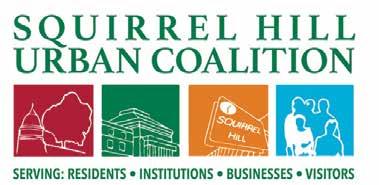
Our Mission
The Squirrel Hill Urban Coalition gives voice to the hopes and concerns of our residents, institutions, businesses and visitors and works to preserve, improve, and celebrate the quality of life in our vibrant urban Squirrel Hill neighborhood.
ON THE COVER:
Detail from Robert Qualters’ Balloons Over Squirrel Hill (1980). Private Collection.
FOR ADVERTISING INQUIRIES
Contact marketing@shuc.org. All other communications can be directed to editor@shuc.org or (412) 422-7666.
We had no trouble coming up with story ideas for this issue— Squirrel Hill is rich in creative culture.
Our streetscapes are layered with visual reminders of past architectural styles and artistic luminaries. Behind our building façades are today’s professional and avocational enthusiasts of art, music, literature, dance, and more.
And Squirrel Hill’s kids are nipping at our heels, ready to add their creative contributions to the mix. I can’t wait to see what they can do!
I hope you enjoy this selection of our many talents.
MELISSA EPPIHIMER
Editor, Squirrel Hill Magazine
R
SQUIRREL HILL URBAN COALITION OFFICERS
PRESIDENT Mardi Isler
VICE PRESIDENT Dalia Belinkoff
VICE PRESIDENT Erik Wagner
SECRETARY Raymond N. Baum
IMMEDIATE PAST PRESIDENT Richard Feder
BOARD OF DIRECTORS
Raymond N. Baum, Justin Berk, Dalia Belinkoff, Guy Costa, Lori Fitzgerald, Heather Graham, Marshall Hershberg, Melissa Hiller, Martha Isler, Paul Katz, Jeremy Kazzaz, Rachel Lecrone, Joseph Ott, Jon Prince, Mary Shaw, Lisa Steindel, David Vatz, Erik Wagner
The Squirrel Hill Magazine is a publication produced by the Squirrel Hill Urban Coalition (SHUC), a nonprofit organization. As a non-profit 501(c)(3) organization, donations to SHUC are tax-exempt, and SHUC complies with all 501(c)(3) rules and regulations.
CONTRIBUTORS
Maria Cohen, Nina Cranor, Melissa Eppihimer, Larry Gerson, Mardi Isler, Kimberly Kweder, Jim Rogal, Helen Wilson, Sam Zlotnikov
EDITOR Melissa Eppihimer
DESIGNER Karen A. DeTurck
EXECUTIVE DIRECTOR Maria H. Cohen
Squirrel Hill Magazine, Vol. 22, Issue 1, is provided by the Squirrel Hill Urban Coalition as a free service to the residents and businesses in the 15217 zip code. Subscriptions are available for $25/year. No portion of this magazine may be reproduced without permission. Printed by Knepper Press.
Magazine
Vol 22 |
1
2 | shuc.org
Issue
Spring 2024

facebook.com/

instagram.com/

twitter.com/ squirrelhillmag

GREETINGS FROM THE SHUC PRESIDENT by Mardi Isler
COMMUNITY CHAMPION: KEN DOYNO by Jim Rogal
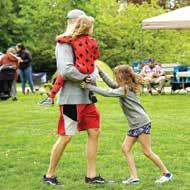
STATE AND CITY COUNCIL CORNER
NEIGHBORHOOD NOTES
SHUC SNAPSHOTS

GOOD NEWS FROM OUR SCHOOLS YOUTH VOICES by Nina Cranor
PET POINTS
by Lawrence Gerson, VMD
SQUIRREL HILL HISTORY by Helen Wilson
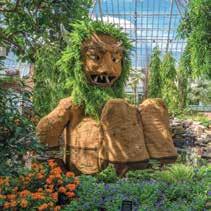
CELEBRATING THE 2023 SQUIRREL HILL TREASURES
THE ROOTS OF CREATIVITY: EXHIBIT DESIGN AT THE PHIPPS
by Kimberly Kweder
ROBERT QUALTERS: LIFE’S CREATIVE WORK by Melissa Eppihimer
TURNING PAGES, BUILDING CONNECTIONS: HOW BOOKSTORES ENRICH THE SQUIRREL HILL COMMUNITY by Sam Zlotnikov

BUNNY BAKES: NOW OPEN—FOR EVERYONE by Melissa Eppihimer

2024 features in every issue
SPRING
squirrelhillmagazine
squirrelhillurbancoalition
4 10 12 21 32 36 38 42 44 8 14 18 24 28 32 18
shuc.org/blog
14 42 Spring 2024 | 3 28
MESSAGE FROM THE PRESIDENT
Greetings from the SHUC President
By Mardi Isler, SHUC Board President
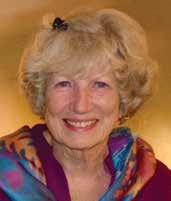
IN JANUARY, SHUC ENJOYED A MOMENTOUS OCCASION: ACTION HOUSING HELD A RIBBON CUTTING FOR FLATS ON FORWARD, their new apartment complex at the MurrayForward intersection.
The opening marked an important achievement in a long-held community vision for a welcoming, attractive
became more aware that urban blight was front and center when arriving in Squirrel Hill from the parkway— an unfortunate first impression for our wonderful residential neighborhood.
In 2009, we received a grant from the Design Center to begin tackling this concern. The funding allowed us to select an architect, Rothschild Doyno Collaborative, and a landscape architect, Pashek Associates, “to produce a comprehensive design that creates a welcoming and engaging entrance corridor for visitors and residents coming from the Parkway into Squirrel

Gateway to Squirrel Hill. I’d like to take this opportunity to recap what it took to get to this point and to honor the many public and private partners that joined SHUC in our efforts.
It all began in the 2000s when SHUC formed a committee to work with a private developer who was planning to build a hotel at Forward and Murray. Because of the economic crisis of 2008, that plan never went forward, but by studying the corner, members
Hill,” as the resulting Gateway plan announced. With input from a series of community meetings, this sketchbook laid out plans for adding streetlights on Murray Avenue, installing a welcome sign at the Parkway entrance, and adopting the nearby Forgotten Garden. The plan stretched beyond the Gateway as well, looking to create a respite

SHUC would like to thank the following sponsors
Brandywine Communities
State Senator Jay Costa
4 | shuc.org
Ribbon cutting at Flats on Forward.
Sketch from the 2009 Gateway plan.
The opening marked an important achievement in a long-held community vision…
plaza at Phillips and Murray and make business corridor improvements, including streetlights and street trees. SHUC immediately began to seek funding for each component.
The first improvement came in 2010 with new trees on Forbes funded by the city. Celebration Maples, Accolade Elms, and Honey Locust trees were planted in a pattern from Murray to Shady. Next, SHUC sought partners to fund and reestablish the Forgotten Garden near the Parkway. Giant Eagle and Sestili Nursery donated to secure Western Pennsylvania Conservancy support, which continues today as Michael Rosenbaum, our gardener extraordinaire, tends to the garden using water supplied by PennDot.
We then learned from Guy Costa that the city had streetlights in a warehouse that were owed to Squirrel Hill, having been purchased by Councilman Cohen but never installed. Thus began the march of lights up Murray Avenue: first 46 from Forward to Phillips with a contractor in 2010, next 35 from Phillips to Beacon
in 2012, and finally 28 from Beacon to Forbes in 2013 thanks to the City of Pittsburgh DPW Construction Division. A grant from Mayor Ravenstahl’s Taking Care of Business program provided funds to purchase the “Sq Hill” banners for the streetlights.
In 2013, Councilman O’Connor purchased a clock to mark O’Connor’s Corner. That year, it also became apparent that many of the desired improvements required significant funds and construction drawings were needed to make the case to foundations and government. SHUC applied to the Design Center once more, and a second grant was approved to provide construction drawings for the welcome sign, O’Connor’s Corner, a respite area at Beacon, and renovations to the Post Office parklet.
The URA funded the welcome sign while SHUC raised matching funds and additional resources for lighting, all of which was completed in 2014. In 2015, with the approval of USPS, support from Mayor Peduto, and the City’s DPW Construction Division, the Post Office parklet was renovated as a respite and gathering place. The bench was funded by Councilman O’Connor, lighting funds were received from Duquesne Light Foundation, and materials were funded by Grable Foundation and SHUC.
Elsewhere in the neighborhood, ten squirrel-shaped bike racks were donated by John Katz of Brandywine Communities in 2016. We now have 30 of them, endearing but practical as they scurry on Forbes, Murray, and Shady.
of the 2024 issues of Squirrel Hill Magazine.
Spring 2024 | 5
MESSAGE FROM THE PRESIDENT
State Representative
Dan Frankel
City Councilperson
Erika Strassburger
City Councilmember
Barb Warwick
MESSAGE FROM THE PRESIDENT

Improvements at O’Connor’s Corner.
Our focus in 2017 was to submit grant requests for O’Connor’s Corner; we soon received grants from Allegheny County CITF and Colcom, then from PA Greenways, Trails, and Recreation Program (GTRP), and later from Jack Buncher Foundation. During this time, we signed an encroachment agreement with Lucia Levantis, whose private property abutted the public right of way. SHUC replaced the pavement, made two businesses accessible, and added benches, a mural, trees, and planters; Gateway upgraded the bus shelter. After delays due to Covid and supply chain issues, the dedication of O’Connor’s Corner took place in 2021. We continue to improve the space: protective tree pit grates were installed in 2022.
Through TreeVitalize, SHUC planted trees at the plaza at Murray and
Beacon in 2019 in preparation for creating another respite area. John Katz, the property owner, then renovated the corner, installing more trees, a bike repair station, and tables and mushroom seating. John accessorizes this popular corner seasonally with lighting and plantings—especially benefiting Farmers Market visitors and chess players.
This history of recent improvements suggests just how much has been accomplished in the last 15 years, but the numbers are also telling. This work represents $1,173,000 invested in our community. In the map shown here, #1 (the trees on Forbes) represents $30,600; #2 (streetlights and installation), $630,864; #3 (the parkway entrance garden), $21,950. #4, (O’Connor’s Corner), $285,500; #5 (the welcome sign and landscaping), $26,600; #6, (Post Office parklet),
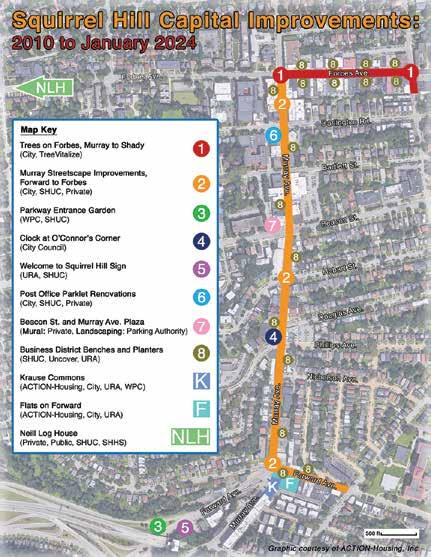
6 | shuc.org
$127,960; #7 (Beacon and Murray plaza), $202,400; #8 (benches and planters), $49,600.
The map also suggests the importance of the MurrayForward intersection to Squirrel Hill, which leads me back to where I began, to Flats on Forward (F). This $27 million project is Action Housing’s second contribution to the Gateway improvements. The organization first opened Krause Commons (K), a $17 million investment, in 2018, right next door. The buildings, which replaced the two worst examples of blight in our Gateway, are aesthetically pleasing, have context with the neighborhood, and will be well maintained, as is Action Housing’s practice.
The road to this point has been long, but it was paved by many individuals and organizations who worked together to make the improvements happen. SHUC is grateful for their efforts and for the team spirit that prevailed.
We’re also ready to keep going. In 2023, SHUC secured a Forbes Fund award to develop a community engagement and financial strategic plan. Through our conversations with the community, we learned that neighbors wanted more benches and planters in our business districts. SHUC has applied for and received a grant from the URA, so look for additional benches and planters to be installed in 2024. We’re also busy as the 501c(3) fiduciary for Friends of the Neill Log House and the $304,000 it has raised so far. We look forward to continued renovations at the site and the development of an educational curriculum and scripts for tours of this historic landmark.
For the future, we are committed to listening to our residents, to making connections, and to supporting changes that promote health, happiness, and a sense of belonging. We ask that you use your voice, get involved, and help us build a better Squirrel Hill.
The Pittsburgh Penguins Foundation was established in 2010 and is the charitable giving arm of the Penguins organization. Guided by four pillars – Wellness, Youth Hockey, Education and Community – its mission is to be the champions of all youth in the community, on and off the ice, through the power of hockey.
With the help of Penguins players, coaches, fans and front office staff, the Pens Foundation raises more than $4 million a year to support unique programming and wide-ranging community outreach efforts. Together, they strive to promote the sport of hockey and use its platform to cultivate healthy Minds, Lives and Communities.
For the latest updates on the work of the Pens Foundation, or to learn more about how you can get involved, please visit www.pittsburghpenguinsfoundation.org.

Spring 2024 | 7
Celebrating the 2023 Squirrel Hill Treasures

On November 8, 2023, the Squirrel Hill Urban Coalition joined members of our community to honor the 2023 Squirrel Hill Treasures at the annual Treasures Dinner at The Pittsburgh Golf Club. Ellen P. Kessler, Liz Miller, Helen Wilson, and JFCS Pittsburgh were recognized for their generous service to our neighborhood, city, and region.

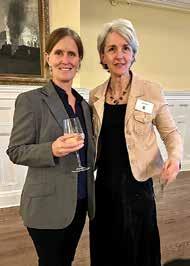




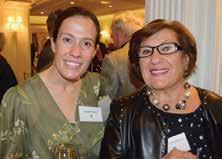

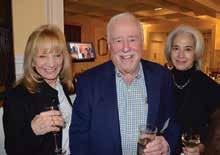
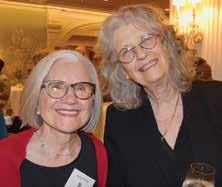




Thank You to Our 2023 Sponsors
Platinum ($5,000+)
Brandywine Communities/Katz Family | Ed Beachler
Debra Kline Demchak | Robert Levin and Dr. Kerry Bron
Pittsburgh Penguins Foundation
UPMC Children’s Hospital Foundation
Gold ($2,500+)
Raymond and Harriet Baum | Carnegie Mellon University
Clark Hill, PLC | Highmark PPO and Highmark Health
Jewish Healthcare Foundation
The Jack and Ellen Kessler Family Foundation
The McGinley Family | Paul Peffer and Leslie Miller
Rockwel Realty/Didomenico Family
Silver ($1,000+)
Buchanan Ingersoll & Rooney | Chatham University
Candy Favorites - The Poller Prince Family
The Honorable Senator Jay Costa
Richard and Helen Feder | Representative Dan Frankel
Halpern Foundation | Jewish Federation of Greater Pittsburgh
Mardi and Bill Isler | Little’s Shoes
Martin and Susan McGuinn | McKnight Realty
Susan and Richard Nernberg | PNC
Kathe Patrinos | Rothschild Doyno Collaborative
James and Louisa Rudolph Philanthropic Fund
The Rubinoff Company | Squirrel Hill Historical Society
Silk & Stewart Development Company




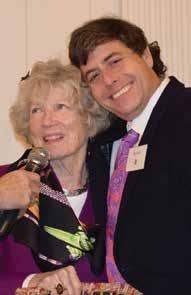
COMMUNITY CHAMPION:
Ken Doyno
By Jim Rogal
KEN DOYNO IS FAR TOO MODEST TO CALL HIMSELF A VISIONARY. BUT IF THE SHOE FITS… The fact is that Doyno’s fingerprints are all over the upgrades, improvements, and major projects that have occurred in and around Squirrel Hill over the last 15 years.
Doyno, a partner in the architectural and urban design firm of Rothschild Doyno Collaborative, seriously began to engage with Squirrel Hill people and projects in 2009, when the Squirrel Hill Urban Coalition (SHUC) hired the firm to help create a long-term vision for the Squirrel Hill Gateway’s evolution over the next couple of decades, one step at a time.
But what began for Doyno as work-for-hire morphed into a significant and ongoing volunteer effort. Doyno couldn’t help but give his time and expertise to a community that he has come to love.
“There’s an inherent worth and dignity to all people, and Squirrel Hill embodies that,” Doyno said. “It’s never been more diverse—restaurants, food, cultural influences. There’s an alchemy that happens here, and I enjoy playing a part in creating a welcoming community.”
Doyno has become a Pittsburgher, but he wasn’t born one. He grew up outside of Buffalo, where in high school he was a front man for a rock ’n’ roll band—lead singer and guitar player. He came here in 1983 to attend the five-year architecture program at Carnegie Mellon, and he’s never left.

His wife, Colleen, is a Pittsburgher and now the Executive Director of Pittsburgh Musical Theater. (Doyno still has music in his blood.) They have a blended family of five children and seven grandchildren. The Doynos live in the “duchy” of Briarcliff at the corner of Forbes and Braddock. It’s partially Squirrel Hill, with a pinch of Regent Square and a dollop of Wilkinsburg. “We like to say that we’re part of Frick Park,” he said diplomatically.
Rothschild Doyno Collaborative’s work for SHUC ended with a master plan that, 15 years later, remains the bible for Squirrel Hill development and improvement. New streetlights, trees planted along Murray Avenue and Forbes Street, even O’Connor’s Corner at the intersection Phillips and Murray—all were part of Rothschild Doyno’s vision. And as SHUC acquires grant money, there are more projects to come.
Since delivering the plan, Doyno has graciously given many hours of volunteer time to SHUC, meeting with city officials, with State Senator Jay Costa and State Representative Dan Frankel, with contractors and perpetual change-maker Mardi Isler.
“How do you celebrate and elevate what’s meaningful?” Doyno asked rhetorically. “This enables me to do that. It’s a part of staying connected to this community, which is not just about a place, it’s about people.”
It is undoubtedly that approach that has, in part, enabled Rothschild Doyno to be involved in many major projects in the East End—the renovation of the Phipps Garden Center in Mellon Park, Chatham University’s development and master plan, and, perhaps most significantly, as the
10 | shuc.org
Courtesy of Ken Doyno.
“It’s what I love about being an architect— engaging with people.”
local architectural firm for the Tree of Life Synagogue. The firm is working in collaboration with world-renowned architect Daniel Libeskind, who is known especially for memorializing historical trauma.

And then there is the Fern Hollow Bridge reconstruction.
At 6:40 a.m. on Friday, January 22, 2022, Doyno heard a massive rumble and crash. He immediately went to see what happened, and that started an almost two-year journey as the de facto representative of the Briarcliff community to multiple constituents active in the rebuild, including the City of Pittsburgh, the Pittsburgh Parks Conservancy, the State of Pennsylvania, and, most critically, the federal government. The bridge and Briar Cliff had been designated as historical, so ultimately everything was guided by the feds.
Doyno voluntarily dove in and was a key part of planning and improving the design outcome and impact, all of which was completed—astonishingly—in less than two years.
“I know there are horror stories about trying to work with government bureaucracies, but the level of cooperation and coordination among everybody was incredible,” Doyno said. He participated in dozens of meetings, provided

considerable counsel that was taken seriously, and continually sought feedback from and reported back to the residents of Briarcliff, the SHUC Ped-Pike Committee, and other community groups. The entire reconstruction went quickly and smoothly, with Doyno playing a pivotal part.
“It’s what I love about being an architect—engaging with people,” he said.
It’s why he loves working on Pittsburgh projects especially. “There is such a sense of neighborhood and community here, pockets of it, defined geographically and culturally,” Doyno said. “It gives Pittsburgh a strong sense of authenticity, of being scrappy. We’re not fake, we don’t have a façade. We’re not Disneyland or a recreated western town for tourists. That’s what makes it so easy for us to be fiercely loyal.”
And the future? “I want to continue to help us grow and change,” he said, “guided by values and a sense of responsibility, passing it on to future generations. That is a profound experience. It’s where meaning comes from.”
Spring 2024 | 11
Ken Doyno (far left) meets with team members involved in the reconstruction of the Fern Hollow Bridge.
Courtesy of Ken Doyno.
Courtesy of Ken Doyno.
Rothschild Doyno Collaborative, Doyno’s architecture firm, created this sketch envisioning a new, more connected Fern Hollow Bridge.




State and City Council Corner
State and City Council Corner shares reports submitted by the elected members of Pittsburgh City Council and the Pennsylvania Legislature that represent Squirrel Hill.
FROM STATE REPRESENTATIVE DAN FRANKEL
State Representative Dan Frankel introduced legislation that will specifically list bringing a firearm into a TSA checkpoint among the reasons for revoking a License to Carry permit in Pennsylvania. In 2023, the Transportation Security Administration (TSA) found 6,737 firearms at airport security checkpoints, beating 2022’s record 6,301 guns. In 100 percent of those cases, the firearm owners claimed they ‘forgot’ they were carrying the weapon. In addition to the obvious safety risk posed by unsecured firearms, this ongoing problem is a drain on TSA resources and a distraction from other dangers that could compromise air travel safety—not to mention a cause of major delays in airports. Responsible gun owners do not forget they are carrying a loaded weapon and don’t need intervention from the TSA to stop them from attempting to board airplanes while armed.
FROM STATE SENATOR JAY COSTA
On January 16, State Senator Jay Costa was proud to announce $1,468,000 in Gaming Economic Development Tourism money benefiting the 43rd senatorial district. Senator Costa noted that he is delighted to be supporting the organizations that support our community, especially those taking new approaches to new housing, safe roads, and green transit. Supporting these crucial community organizations to improve their infrastructure is just one way the Pennsylvania government continues to deliver safe, welcoming spaces for every Pennsylvanian.
Senator Costa went on to announce $565,403 in Act 13 grant funding benefiting the 43rd senatorial district. It’s a great honor to be delivering crucial state funding to the green spaces that allow the people of Pittsburgh to appreciate the natural environment. This community’s parks and playgrounds support children, families, and communities, and Sen. Costa looks forward to seeing these dollars put to work in our neighborhood parks and trails.
12 | shuc.org
From Top to Bottom:
State Representative Dan Frankel
State Senator Jay Costa
City Councilmember Barb Warwick
City Councilperson Erika Strassburger
FROM CITY COUNCILMEMBER BARB WARWICK
Councilmember Warwick was proud to vote in late 2023 to approve the City’s 2024 budget, after advocating throughout the budgeting process for investments to make our streets safer. The final spending plan passed with a 136% funding increase for citywide traffic calming, and a commitment from the Department of Mobility and Infrastructure (DOMI) to implement traffic calming measures on Greenfield Avenue in 2024.
In the beginning of 2024, Councilmember Warwick was sworn in for a full four-year term and was appointed Chair of the Public Works and Infrastructure Committee. Councilmember Warwick looks forward to spending this year collaborating with DOMI and the Department of Public works to ensure our infrastructure is safe and well maintained for every resident.
For additional updates on street safety and other City news, sign up to receive the District 5 office’s monthly e-newsletter at bit.ly/PghD5News.
FROM CITY COUNCILPERSON ERIKA STRASSBURGER
On January 8, we inaugurated the 143rd Pittsburgh City Council, and it was a day of significant change in the Chamber: new and returning Members were sworn in, Councilman R. Daniel Lavelle was elected to succeed Councilwoman Theresa-Kail Smith as Council President, and Councilman Bobby Wilson was elected as President Pro Tempore. Our newly elected Council President also selected Council Members’ Standing Committee assignments, and Councilperson Strassburger is honored and humbled to chair the Committee on Finance and Law. In this role, the Councilperson will lead Wednesday’s weekly Standing Committees meetings and become more involved in questions of City spending, budgeting, and legal affairs. The Councilperson looks forward to working collaboratively with her fellow Council Members and Mayor Gainey’s administration to ensure the City stays on healthy financial footing for the years and decades to come.


































































































































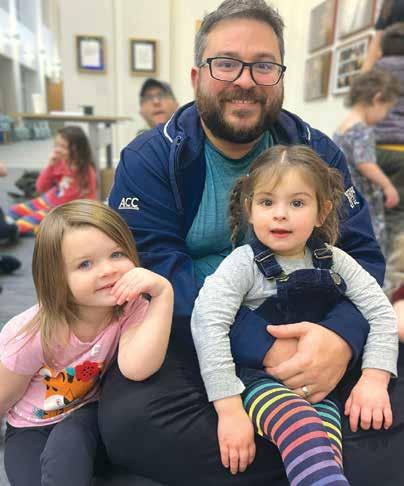
Spring 2024 | 13
Your neighborhood is your home, and that’s where you’ll find us.
you need.
world-class health
system.
the right community
. 5516_SRLIV528302_sq_hill_mag_print_3.625x4.875.indd 1 FAMILIES at the JCC HAVE FUN membership@jccpgh.org 412-697-3522 • JCCPGH.org JOIN US! Mention FAMILY and receive $100 off Family Membership enrollment
With locations throughout Pittsburgh’s neighborhoods, offering a variety of floor plans, many pricing options, and all levels of care, you’ll find just what
At UPMC Senior Communities, you’re part of a
care
Find
for you. Call 1-800-324-5523 or visit UPMCSeniorCommunities.com

The Roots of Creativity
Exhibit Design at the Phipps
By
AN AQUAPONIC GOWN WITH FLOATING FISH, A GIANT TROLL BATHING IN A POND, AND SINGING TREES FLICKERING WITH LIGHTS. These are all products of the creative minds working behind the scenes at the Phipps Conservatory and Botanical Gardens.

“Our seasonal shows allow us to change the beauty inside the garden so we can continue to inspire people in different ways,” said Jordyn Melino, Associate Director of Exhibits at the Phipps. “And they allow us to explore new plants to be a part of the show and new ideas.”
The Phipps offers a world-class garden experience, winning the hearts of visitors since 1893. As the glasshouse oasis has evolved, the space and staffing have grown to produce more artsy seasonal shows, like those including plant-based fashionable attire and colorful holiday lights. Today, the Phipps offers six changing shows a year: Garden Railroad, Spring, Summer, Fall, Winter, and the Orchid and Tropical Bonsai show.
The keys to its creative success are its greenhouses, teams, and guest feedback, explained Melino.
Planning for a seasonal show starts about one and a half years in advance. Melino’s three-person Exhibits
14 | shuc.org
Phipps’ Exhibits team works with other departments to produce special elements like this giant troll.
Photo by Paul G. Wiegman.
Kimberly Kweder
The designers at Phipps created this display of floral abundance for their Fall Flower Show of 1939.
Photo courtesy of Carnegie Library of Pittsburgh Archives.
team works in conjunction with a wider team including about ten people in Facilities and twenty-five people in Horticulture.
“We pitch three to four options to a bigger planning committee that includes every part of the Conservatory and ask two things: what is the biggest ‘wow factor’ and what are the educational connections to the mission? It’s a balance between the two. We also want to incorporate elements for adults and kids and enough to excite all ages,” Melino said.

From there, a concept design is created with rough sketches, and Melino and her team sort out a “plant palette” of plant options they’d like to use. The Facilities and Horticulture teams provide their feedback on what can work well. Afterwards, a final design with full planting and prop plans is created. This design acts as the “blueprint” for the production staff to move ahead with seed orders and growing coordination, while Facilities and Exhibits prepare the props and organization.
“The plants have the longest lead time,” Melino said. There are typically months of growing time involved in setting up an exhibit. The production greenhouses located behind the display gardens are state-of-the art facilities that can monitor the air temperatures and are equipped with LED growing lights.
Our seasonal shows allow us to change the beauty inside the garden so we can continue to inspire …
Spring 2024 | 15
The production greenhouse at Phipps starts growing plants needed for special exhibitions months in advance.
Photo by Kim Kweder.
The Roots of Creativity
An Exhibit Staging Center with space to store and fabricate props, complete with woodworking and painting stations, is located behind the Tropical Forest Conservatory. A portion of the center, which opened in 2019, is visible to guests.
That’s where Lauren Seiple, Exhibit Associate, spends a lot of time with her artful pieces.
“I think I tend to gravitate towards the ideas that bring joy to children and adults. I like to see the guests respond to things we’ve created, like an animal character or a display style that is joyful and happy,” said Seiple.
In the past, Seiple created a topiary cat shaped with a wire frame covered in dried plant materials; the cat sat on a chair planted with succulents. She also made five eight-inchtall fairies with pressed orchid petals as wings.

They were hidden in the Conservatory for people to find during the Orchid and Tropical Bonsai Show earlier this year.
Her biggest creation yet is a giant octopus made of live and dried plants. It will appear in the summer show. Seiple explained that Phipps tries to lead on the sustainability front and select materials that can go beyond just one show.
Her biggest creation yet is a giant octopus made of live and dried plants.
While there is a general flow to how the seasonal shows proceed, there are times when ideas spark and rattle the routine. When that happens, the Exhibit Staging Center plays an even more crucial role.
Take the Flowers Meet Fashion exhibit, which, Melino said, “we would have never done if we didn’t have the [Staging Center] space.” This show, from the summer of 2023, was inspired by fashion icon and Broadway star Billy Porter’s local roots in Pittsburgh. In 2021, he was filming scenes at the Phipps for the movie Anything’s Possible when the staff approached Porter about an upcoming fashion show.
“The opportunity presented itself. He was just so kind and wonderful to work with in this quick process we had with him and knowing he’s a Pittsburgh native,” Melino said.
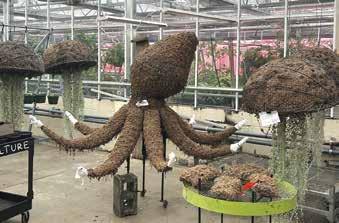
16 | shuc.org
The fairies hidden within this spring’s Orchid and Tropical Bonsai Show had wings made of orchid petals.
Photo by Kim Kweder.
An octopus for the summer show takes shape in the Exhibit Staging Center.
Photo by Kim Kweder.

An aquaponics gown in that exhibit was a hybrid project between the Facilities team and the Horticulture team: a bellshaped gown planted in lettuce and fertilized by fish, where the creatures swam around inside the torso.
“The most challenging part is tackling something we’ve never done before. It’s always easy to hit repeat on things we’ve done, but definitely the most challenging is combining plants and props and trying to push the boundaries and intersection of utilizing the plants in a different way,” Melino said.
Other Phipps special exhibitions came from sources closer to home. Summer 2021’s troll showcase featuring folklore about the forces of nature was a concept from Phipps’ President and CEO, Richard Piacentini.
The exhibit team created individual experiences in each room. A giant six-eyed troll with a scraggly beard and a lantern greeted visitors. An animatronic troll called Bridget the Bridge Troll was motion triggered, with blinking eyes and a collection of riddles for guests. A forest-bathing troll scrubbing a stick on his back sat approximately 15 feet tall in a large pond. The troll itself was made of dried coconut fiber, and its hair was planted in ferns.
“He looked very wild,” Melino said.
The theme of this year’s Spring Flower show, which opens March 16, is Spring Discovery. The show features
magnifying glasses to take detailed looks at the plants, kaleidoscope eye pieces, and a lot of fragrances. The team has to change out the tulip bulbs each week because tulips only last a few days in bloom.
Seiple and a few team members built three giant topiary ants with “Black Scallop” ajuga plants built into them. A checkered picnic blanket is made with white, pink, and red plants (generically known as the “polka dot plant”). On top of the blanket there is picnic food made of dried plant material.
“The flowers and plants sort of speak for themselves. The magic of Phipps is that it’s this green space you can visit in the city no matter what the weather is, so if there is a story we can tell that adds more layers to that magic, I get excited about those show designs,” Seiple added.
Audience engagement is central to Phipps’ operations. Staff periodically use surveys to gain data and insights into what is working well and what can be improved. Recently, Phipps has tried to reach people who can’t physically attend in person by creating virtual video tours for rent or purchase across various devices. Phipps has also partnered with AARP to gain national attention for viewing the gardens remotely.
Phipps is bursting with creativity, and new ideas are never in short supply. For the staff, squeezing their artful creations through the Phipps’ historical doors is the real challenge, Melino said.
“We are limited by the width [of the doors] and getting giant items and carts through them!”
Kimberly Kweder is a writer with a journalism degree from Point Park University and a public administration degree from USC. In her free time, she enjoys hiking in Frick Park with her dog, oil painting, gardening, and exploring the city!
Spring 2024 | 17
Photo by Paul G. Wiegman.
From the Flowers Meet Fashion show, an aquaponic gown houses swimming fish.
Robert Qualters Life’s Creative Work
By Melissa Eppihimer
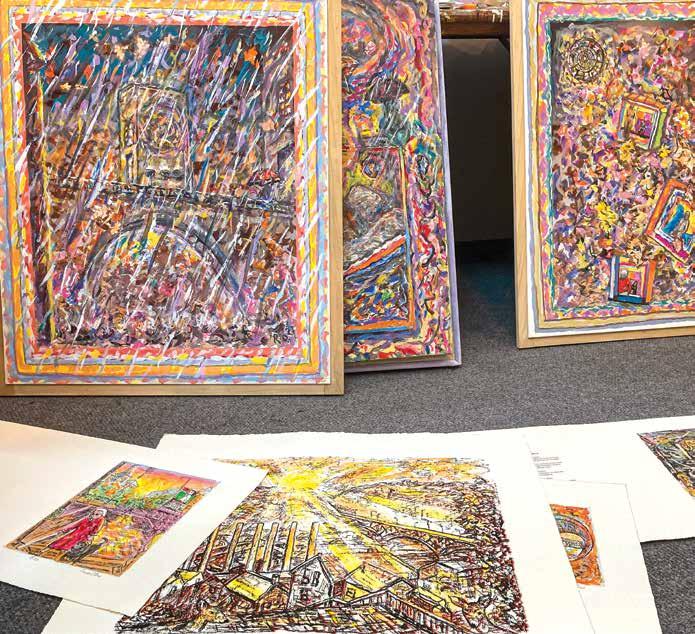
THIS WEEK WAS ARTIST ROBERT QUALTERS’ 90TH BIRTHDAY. A CAKE AND A GATHERING OF LOVED ONES MIGHT BE A SUBLIME WAY TO CELEBRATE THIS MILESTONE. Qualters is marking the occasion with an exhibition of his latest paintings at the Borelli-Edwards Galleries in Lawrenceville.
Qualters has been painting, drawing, making prints, and producing sitespecific works of art in the Pittsburgh area since a childhood spent in McKeesport and Clairton. Except for a few years studying art in California and teaching it in New York, his life has been rooted in the region. He’s lived in Squirrel Hill since 1968, and the neighborhood makes cameos in his paintings.
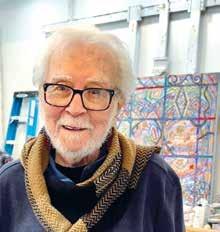
18 | shuc.org
Qualters’ love of color is apparent in this mix of new paintings and older prints.
Robert Qualters
Qualters’ art is known for its bright colors, strong brushstrokes, and evocative subjects. He is a frequent painter of Pittsburgh’s iconic buildings and vistas, but as often as one recognizes familiar places in his work, the familiar is interrupted by the fantastical. In Orangutan Dreams (1999), an orangutan and a nude woman walk down Murray Avenue at the intersection with Hobart Street.
As this painting suggests, Qualters feels free to explore the ideas that come to mind.
Recently, he returned to Seasons, a rather large painting he began many years ago in dialogue with Gail Ghai’s poem “Two Phone Calls.” In its earliest iteration, Qualters created two slightly overlapping circles in reference to the two deaths mentioned in the poem. Later, Qualters filled the space around the circles with emblems of the seasons, like a baseball and a bird for spring. Now, he’s added a lattice-like fence across the entire surface; it’s reminiscent of a similar feature in Orangutan Dreams, which sits in his studio.
Although Qualters’ artistic vision is apparent in all that he does, the works that result from this kind of flexible process, he said, are “the most interesting things to work on, when you don’t know what you are doing.”
And Qualters is open to suggestions.
After a caretaker came in one day and said that Seasons looked like stained glass, Qualters added sections with black frames and colored insets that even more clearly resemble stained glass.
After many decades of work, Qualters is in what he calls the “easeful” phase of his career. “I’ve strived a lot,” he said.
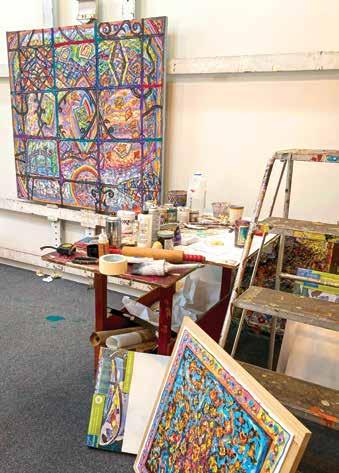
Although he tries to paint four hours a day, two before noon and two after, he acknowledges that it’s not always possible. Rather than worry about what this means for his art, Qualters takes it in stride, appreciating what he is still able to do.
A series of twelve new paintings involve a collaboration with a photographer, Mark Perrott, and a digital specialist, Tom Underiner of Pixel River. The three have worked together for a long time. In these new works, Qualters paints over Perrott’s photographs. The pieces differ in how much the added paint obscures the underlying photograph. Some are so heavily overpainted with Qualters’ distinctive colors and brushstrokes that little of the photograph remains to be seen. In others, Qualters’ touch is rather light.
Spring 2024 | 19
The painting Seasons hangs inside the artist’s studio.
Robert Qualters Life’s Creative Work
In one case, there is a fourth collaborator: the 19thcentury Japanese artist Utagawa Hiroshige. The foundation of Homage to Hiroshige is Perrott’s studio portrait of Qualters seated on a wooden chair, looking down as brown leaves cascade around him. Within this photograph Underiner has digitally blended in imagery from a Hiroshige print depicting a sudden rain. Finally, Qualters added a painted border, preferring to leave the hybrid photograph mostly intact.
As the portrait of the artist suggests, the new works are partly biographical. In Grandpa, the artist’s shoes share space with a drawing of him produced by his now-adult granddaughter when she was little. Qualters brings together fragments from a life on the surface of the painting.
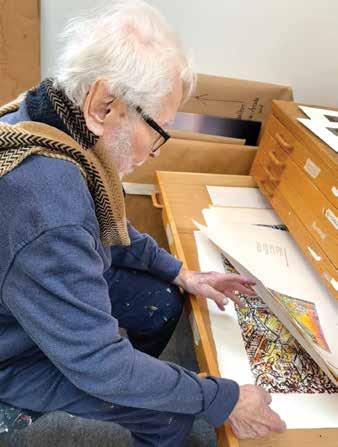
As often as one recognizes familiar places in his work, the familiar is interrupted by the fantastical.
The same principle underlies the decorations in his studio. On a shelf high above the workspace sit several mementos: a candid photo with his grandson, a collage bowl gifted to his late wife by a fellow artist, a bowling trophy, a dancer figurine.
The bookends to these tangible memories are two paintings: a self-portrait from the 1960s and a painting that once hung on the walls of his childhood home. Darkened by time and, no doubt, the pollution from the steel mills nearby, that second painting, Qualters says, depicts one of the Fates of Greek mythology.
The work of the Fates was creative work, turning raw material into exquisite thread. The thread contained within it all of a person’s destiny. At the end of the spinning process, the thread was cut to fix its length— and to determine the end of a life.
The Fate that overlooks Qualters’ studio is still spinning thread, and like hers, Qualters’ creative work is far from finished.
The photos of Qualters’ works appear here courtesy of the artist.
20 | shuc.org
Qualters examines some of the prints he’s made over the years.

NEIGHBORHOOD NOTES
NEW BUSINESS NOTICE

CUVEE BOTTLE SHOP
Cuvée Bottle Shop (5886 Forbes Ave) may be new to Squirrel Hill, but its practice of offering an expertly curated selection of specialty wines and beers is not. In fact, it began during the pandemic, when The Independent Brewing Company—located just around the corner and operated by the same team—started offering cocktails, beer, and wine “to go.” Now, thanks to an enthusiastic response from customers, the bottle shop has taken on a new name and space of its own.
Cuvée’s shelves are stocked with items you won’t generally find at a Pennsylvania Liquor Control Board store. Wine is sourced from small vintners or overlooked regions like the country of Georgia, where wine production occurs in clay pots buried underground. Cuvée’s shelf of lambics offers beer-lovers a chance to explore the many varieties of this complex Belgian beer.
Through close relationships with makers and distributors, Cuvée’s team procures beverages that are hard to get, limited edition, or require special care. The selection is about more than just rarity, however.
“Our goal is to offer the best wines and beers that we can for the best value, no matter where they come from,” said co-owner Pete Kurzweg.
While the offerings are always changing, if you fall in love with something, they’ll do their best to get it for you again. If you don’t yet know what you’re looking for, Cuvée Bottle Shop’s well-informed staff are ready with suggestions and a pour of the drink that’s currently being sampled. The shop’s cozy and laid-back vibe makes it easy to imagine you’re at home, enjoying something special.
Cuvée Bottle Shop’s current operating hours are Wednesday to Friday, 2 to 8 pm and Saturday, 12 to 9 pm.
YOUNG ARTISTS LEARN AT THE LIBRARY
The Carnegie Library branch in Squirrel Hill has long been a place of fun and learning for kids, but visitors may have noticed some young artists hard at work recently. This school year, the library is one of two Carnegie Library of Pittsburgh (CLP) sites hosting art classes run by ProjectArt. (The other is the Allegheny branch.)

ProjectArt is a nationwide nonprofit that seeks to fill the opportunity gap in arts education by offering free art classes to young people in libraries. Students in ProjectArt classes, which are divided by age, pursue multi-week projects in various media and techniques. At the end of the year, they help design an exhibition of their work. The Squirrel Hill students’ show will open the week of May 20. In a separate exhibition in the city,
Spring 2024 | 21
Photo by Tom O’Connor

NEIGHBORHOOD NOTES
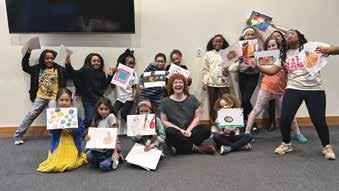
ProjectArt’s local teaching artists will present their own work inspired by their engagement with the students.
Squirrel Hill’s classes are run by Teresa Audet, a trained furniture maker whose art mixes sculpture, basketmaking, and woodworking. She enjoys introducing her ProjectArt students to types of art that they might not be exposed to in school—if they are lucky enough to have art classes in school. Many students enrolled in ProjectArt’s classes don’t.
“Teaching at the library has been so exciting because I get to mix my own art practice with the resources at the library to create unique multi-week art projects for these young artists,” said Audet. “Our projects come from my background teaching craft workshops to adults, the incredible selection of art-related children’s books at the library, and the foundational curriculum from ProjectArt.”
Beyond its educational impact, ProjectArt fosters relationships. “Undoubtedly, the most important connections forged are between our students and their teachers. We emphasize mentorship—creating safe, relaxed, and creative atmospheres for our students to grow and for our artists to work directly with the youth in their communities,” said Adarsh Alphons, ProjectArt’s Founder and Executive Director.
ProjectArt has conducted classes in various CLP branches since 2017, supported by funding from the Trivedi Family Foundation. Carlton Stout, CLP’s Assistant Director – Neighborhood Libraries, explained how the collaboration contributes to the library’s purpose. “Carnegie Library of Pittsburgh’s mission is to engage our community in literacy and learning. Learning to express yourself, engage your imagination, build your art skills, and be with others on the same journey absolutely fits with this mission,” said Stout.
If you know a child between the ages of 4 and 18 interested in joining ProjectArt’s Pittsburgh classes, openings can be found here: https://afterschoolhq.com/ projectartpittsburgh. Students must be pre-registered to attend. All classes are free, and materials are provided.
BECK BECOMES SUPERIOR COURT JUDGE
Earlier this year, Squirrel Hill resident Jill Beck was officially installed as a Judge of the Superior Court of Pennsylvania. Elected to the court last fall, Beck brings to the position her experience as a practicing lawyer and as a law clerk for former Superior Court judge Christine Donohue, who is now a member of the Pennsylvania Supreme Court. As a
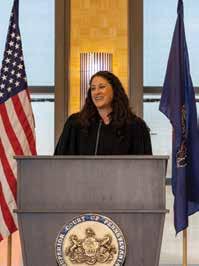
22 | shuc.org
Superior Court judge, Judge Beck operates within the Pennsylvania judicial system’s appeals process, hearing criminal and civil cases previously decided at the Court of Common Pleas level. She is one of 15 Superior Court judges in the state.
Beck previously served as a member of the Squirrel Hill Urban Coalition board.
WARWICK JOINS CITY COUNCIL FOR FULL TERM

In January, Barb Warwick was sworn in as a Member of Pittsburgh City Council representing District 5, which includes Squirrel Hill South, Greenfield, and several other nearby neighborhoods. Warwick had been serving as the District 5 representative since winning a special election in 2022 to complete former City Councilman Corey O’Connor’s term after he became County Controller, and last November, Councilmember Warwick won election to a full four-year term.
CELEBRATE ARBOR DAY IN MELLON PARK!
In celebration of Arbor Day and Mellon Park, Friends of Mellon Park will sponsor its 4th annual family-friendly event on Saturday, April 27, on the south side of the park from 11:00 am to 2:00 pm.

NEIGHBORHOOD NOTES
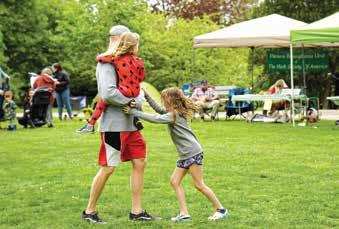
Friends of Mellon Park, a volunteer group advocating for the park, worked with City officials to create Pittsburgh’s first public arboretum in 2021. This milestone was celebrated in April of 2021, and the Mellon Park Arbor Day celebration was born. The first celebration was small because of Covid, but it was an exciting accomplishment.
A major part of the mission of Friends of Mellon Park is to engage others in appreciating, respecting, and caring for the beautiful greenspace that is the park. With that goal in mind, a free public event was inaugurated in April of 2022.
Every year since, local government, community organizations, environmental groups, and schools are invited to participate. Each table at the event offers a nature-based activity for children. In the past there have also been lawn games, scavenger hunts, and seedlings to take home and plant. There’s always food and a variety of music—from a marching band to local musicians.
What began as a small event to inaugurate the Mellon Park arboretum has blossomed into an annual neighborhood celebration!
Spring 2024 | 23

Turning Pages, Building Connections
How Bookstores Enrich the Squirrel Hill Community
By Sam Zlotnikov
W
HEN YOU WALK THROUGH THE DOOR OF A BOOKSTORE, YOU KNOW YOU HAVE AT LEAST ONE THING IN COMMON WITH EVERYONE INSIDE: A LOVE OF BOOKS. Whether you’re there for a particular title, a general browse, or
to find shelter from Pittsburgh’s unpredictable weather, it’s surprisingly difficult to leave empty-handed. In the boundless journey of making your choice, it’s easy to find someone or something you weren’t expecting.
Everyone has their favored sections. I head straight to art history, but always end up meandering down the shelves until I’m far off my original course. Amidst the welcoming racks I am compelled to linger, whether simply to enjoy the cozy atmosphere or to hope for a chance encounter with a new and intriguing book. Others often do the same. You might see a philosopher learning about quantum mechanics to support their novel theory on the meaning of life, a piano teacher with a passion for ethnomusicology stumbling upon a cultural history of the Aboriginal Australians, or an out-of-towner picking up a local author to remember their time in the city. During these stretches into new sections, a bookstore’s environment catalyses unlikely interactions between patrons—merely by its presence.
24 | shuc.org
Unfortunately, not every day mimics an old Hollywood film. I’ve never seen two soon-to-be lovers begin on either side of the fiction section, slowly but surely approaching one another only to have their fingers touch on a book by Melville, Mitchell, or another author with a conveniently middle-of-the-aisle last name. But I’ve seen plenty of genuine, kind-hearted meetings take place.
Perched behind the counter one slow autumn evening, I watched a regular customer stride briskly into the philosophy section. Being a local professor with defined interests but insatiable curiosity, he took his time to explore each volume. As he did so, a young woman entered and joined him between the shelves, on her own mission. She pulled out a gorgeous copy of the Myth of Sisyphus, its mylar wrap holding a lively, geometric 1960’s dust jacket. The gentleman, glancing over to her book of choice and noticing a familiar title, struck up a conversation. I could hear them discussing their love of Albert Camus and existential philosophy in general.
As their interests converged and the discourse grew animated, the two attracted several other groups hovering about the store. A couple from the poetry section was piqued by the philosopher’s passion for love and life; one man, emerging from the religion section, joined to lament the rise of nihilism; a group of students on entering the bookstore couldn’t help but join in. By the end, I felt much like a passer-by to Socrates and his dialogues in the ancient agora. They eventually dispersed, though the conversation had hardly concluded. The professor ran an ongoing discussion group at his university, and every participant planned to join its next meeting to continue their discussion.

Such a case is not an isolated incident. A student at CMU pursuing his PhD in Mathematics entered at two in the afternoon on a Wednesday. Searching for The Count of Monte Cristo, I scanned the “D” shelf of our fiction section but found no copy. About to bear the bad news, I heard an excited voice from the stacks shout, “Over here!” A few minutes before, a young woman had spotted an elusive copy of the Count hiding in our business and accounting section, and she hurriedly brought it to the counter. They spoke for quite some time, eventually leaving together for a spontaneous dinner. A week later, the student brought me an undeserved bottle of wine as a thanks for their chance encounter. “We’ve gone birding twice,” he proudly boasted.
Through these encounters and many others, my time behind the counter at Amazing Books and Records has been endlessly colorful. And in my observations, I believe I’ve come to realize the truth about community: it is not
Spring 2024 | 25
Turning Pages, Building Connections
always embedded in institutions or municipal boundaries, but often finds its home in the casual interactions of neighbors and their meaningful personal connections. In this context, a bookstore is a unique institution. It enables one to share their story with others, on purpose or by chance, creating new and lasting community ties.
Central Squirrel Hill proudly boasts two bookstores on Forbes Avenue, each complementing the other perfectly: Amazing Books and Records provides used books to our community, while Riverstone Books supplies modern titles. Together, these stores have excelled in creating novel methods of supporting Squirrel Hill. Amazing Books hosts book and beer nights, offering free beer (to those of age) and non-alcoholic drinks while customers browse on Thursday and Saturday evenings. Eric Ackland, its owner, often hosts ‘pop-ups’ of local vendors, including the Greenhouse Co-op, Chocolate Moose, Liberty Pole Spirits, and countless others. On Sundays and major holidays over the winter, they offer free coffee and hot chocolate for all who enter.
Besides author signings, readings, and other bookspecific events, Riverstone Books hosts many recurring gatherings. Robin Guenther, a Riverstone employee, leads story time on Sunday mornings for kids approximately one to four years old, reading stories,


singing songs, and organizing crafts. Locals interested in exploring new cooking styles are welcome to join Riverstone’s cookbook club, where members select a style of food or a particular dish, prepare it at home, and discuss their exploits afterwards. Crafters of all sorts are invited to ‘sip and stitch’ evenings, an inclusive space for avid and procrastinatory artists to further their projects while sipping on a glass of wine. And for voracious readers, their book club offers an opportunity to stay afloat in the (perhaps fortunately) never-ending sea of modern literature.
For more information about local events at Amazing Books and Records and Riverstone Books, please visit their locations on Forbes, follow their pages on social media, or contact your local bookstore employees. Our community’s spirit is here in Squirrel Hill bookstores. Come join us!
Sam Zlotnikov has been an employee at Amazing Books and Records since December of 2018. He currently co-hosts their book and beer nights on Thursday and Saturday evenings.
26 | shuc.org


10

10
QUESTIONS? Contact Molly Newman at learning@jfedpgh.org or 412-992-5243.

5 Sessions • ZOOM MARCH 21–APRIL 25


Leading
1 Session • ZOOM APRIL 14
Pirkei
6 Sessions • In Person: Rodef Shalom MAY 1–JUNE 5

QUESTIONS? Contact Patti Dziekan at pdziekan@jfedpgh.org or 412-992-5221.

Kedoshim:
In


REGISTER TODAY
Underwritten by the Alan Papernick Educational Institute Endowment Fund.
Foundation. The Wisdom of Abraham Joshua Heschel
The Gefsky Community Scholar position is
endowed
by the H. Arnold and Adrien B. Gefsky Endowment Fund of the Federation’s Jewish Community
Sessions • ZOOM
20–MAY 14
in Judaism
FEBRUARY
Love
Avot – Illuminating Chapters From the Mishnah
a Post-
Seder
October 7th
A History of the Arab-Israel-Iran Conflict: All You Need to Know
Sessions • ZOOM
22–MAY 23 Continuing Legal Education 2023-24 Series • 8:30-10:45 AM on ZOOM Classes are generously supported by the Elaine Belle Krasik Fund for Adult Education Full inclusion is a core value of Jewish Pittsburgh. The Jewish Federation welcomes invitees of all abilities, backgrounds, races, religious affiliations, sexual orientations and gender identities. The cost of taking a course is never a barrier to participation. If price is an issue, or if you need accommodation for a disability, please contact Molly Newman at learning@jfedpgh.org or 412-992-5243 so that we can make the course accessible for you. The Legal Dimensions of Shabbat MARCH 28 jewishpgh.org/explore/federation-learning JEWISH FEDERATION SPRING ADULT LEARNING CLASSES With Gefsky Community Scholar Rabbi Danny Schiff
FEBRUARY
Elevated
Behavior
Person: Rodef Shalom MAY 9
Danger
Permit?
Risk-Taking: How Much
Does Jewish Law
JUNE 6

Now Open—for Everyone
 By Melissa Eppihimer
By Melissa Eppihimer
HAT’S THE BEST WAY TO DESCRIBE
BUNNY BAKES & SPECIALTY COFFEE? IS IT A COFFEE SHOP? A bakery? An inclusive business? An agent for social change?
It’s all of these at once. Located next to its parent organization, The Friendship Circle, Bunny Bakes opened its doors last fall with a multipronged mission: to serve delicious coffee and baked goods to the Pittsburgh community in an attractive, modern coffee shop that trains and employs people of diverse abilities.
The desire to merge and balance these diverse goals drove Rabbi Mordy and Rivkee Rudolph as they shepherded Bunny Bakes from conception to reality,
28 | shuc.org
Universal design principles make the coffee shop’s interior an accessible space.
helped along the way by many who share their vision of a more inclusive community.
The Rudolphs founded Pittsburgh’s Friendship Circle in 2006. At Friendship Circle, people of all abilities, needs, and talents socialize and support each other. Its programming for families, kids, and young adults has positively impacted Friendship Circle’s many members. But the Rudolphs wanted to expand this model of inclusivity to reach more of the community beyond Friendship Circle.
Squirrel Hill, the Rudolphs realized, was already a neighborhood centered on social interaction. There’s a grocery store, a post office, a movie theater, and a diverse set of shops and restaurants bringing all kinds of people together at street level. What Squirrel Hill needed was to become more accessible to differently abled people—and for that accessibility to become more visibly integrated into the community.
A coffee shop seemed the ideal place to start. From the community’s perspective, it’s open to everyone, even if they only have two minutes to grab a morning coffee. From an accessibility perspective, a coffee shop could introduce Friendship Circle’s young adult members to different aspects of the business, from pastry prep behind the scenes to interacting with customers at the checkout counter. If they got the balance

right, the shop would be, first and foremost, a coffee shop— only one that happens to be focused on inclusion.
To that end, Bunny Bakes was designed to look like a serious coffee shop. The sleek décor in neutral tones sprinkled with olive green accents promotes concentration for those who want to work, while several communal tables invite conversation over coffees and teas sourced from De Fer Coffee & Tea in the Strip District. Bunny Bakes, through and through, is a serious coffee shop.
It is also a destination for anyone with a sweet tooth. An array of fresh cinnamon rolls, rugelach, and cookies—all made in-house in the kosher bakery led by experienced lead pastry chef Julie MazerRemaley—tempt the taste buds upon entering. Named in honor of the late Bernita “Bunny” Buncher, a patron of Friendship Circle, the bunny theme is subtly worked into Bunny Bakes’ offerings. The sugar
cookies have rabbit ears, and a carrot cupcake is a staff and customer favorite.
Among those who make and sell these treats are Friendship Circle members with diverse abilities. Even before Bunny Bakes opened, Friendship Circle’s training program had been preparing members for employment. Now, with a dedicated space, this program has entered a new phase. Through their work at Bunny Bakes, trainees learn professional skills and develop work experience. Although some work at the coffee shop, participants also ready for employment in other businesses as well.
Those who work at Bunny Bakes are able to apply their skills in an environment that also meets their needs. Chet Stofman works one 2.5hour shift a week at Bunny Bakes. Stofman, who has cerebral palsy, is assisted by caregivers as he folds and stamps bakery boxes before stuffing them with goodies.
“He enjoys and appreciates his vital role in the process,” said Carol Tabas, Stofman’s mother. “He’s part of the wheel that turns and makes it go. It’s important that he feels that he has a place.”
Universal design principles have made Bunny Bakes physically accessible throughout. For customers, narrow table bases allow individuals in wheelchairs to sit at any table, rather than a designated spot. There’s even space
Spring 2024 | 29
The bunny theme pops up in charming ways at Bunny Bakes.
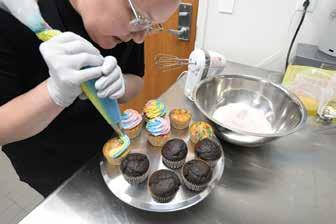
for someone in a wheelchair to join the coziest corner booth. The lighting and soundtrack can be adjusted to the comfort of guests, and a restroom houses an adult changing table.
CLASSICS ENDURE
BNY
MARCH
BNY
APRIL
*Thursday
BNY
Many who enter the shop may not even notice these accommodations. That’s by design. Bunny Bakes is meant to be an inclusive business, not a refuge for people with disabilities or special needs. It is by all and for all, an innovative step towards making Squirrel Hill a more inclusive community.
“We’re thrilled it’s there,” said Tabas.

Bunny Bakes & Specialty Coffee
is located at 1926 Murray Avenue and is open Tuesday through Friday, 8 am to 2 pm, with extended hours until 5 pm on Thursday.

ADAMLIU,CELLO TITLE SPONSOR pittsburghsymphony.org
best seats don’t. Get your tickets NOW.
The
MELLON GRAND CLASSICS
Hahn Plays
Fantasy
Hilary
Carmen
22, 23 & 24
MELLON GRAND CLASSICS
Symphony No. 9
Beethoven
26, 27
28
25,
&
Night Added*
MELLON GRAND CLASSICS
& Firebird:
Season Finale
Fifteen
The
15,
16
JUNE 14,
&
Julie Mazer-Remaley decorates cupcakes made by Bunny Bakes’ staff and participants in its work training program.



 NOTES FROM YOUR SQUIRREL HILL URBAN COALITION STAFF
NOTES FROM YOUR SQUIRREL HILL URBAN COALITION STAFF
UPDATE FROM SHUC EXECUTIVE DIRECTOR, MARIA COHEN

Coming out of our winter hibernation and into the spring, we look forward to using our creative energy to reengage in fun activities, concerts, outdoor sports, and so much more. In the Lunar New Year tradition, this is the year of the Dragon, a symbol of good luck, justice, prosperity, and strength. Moreover, it’s specifically the year of the Wood Dragon, which is believed to cultivate growth, progress, and abundance. This gives us hope for what’s to come.
Looking back at 2023, I’m reminded of several challenges we faced as a community, including an overactive deer population, lanternflies, the Tree of Life trial, and worldwide events that divided us locally and nationally. But, Squirrel Hill, we are the definition of resilience and community strength! We came together to tackle our issues, finding solutions that were beneficial to our community. We have a solid city plan for deer management thanks in large part to our SHUC Board President Mardi Isler; our Summerset at Frick Park community hosted an incredible Halloween event with the support of our city despite an anarchist group tagging the newly built URA park with anti-Semitic and anti-LTGBQ+ graffiti the evening before; and thanks to the Jewish Federation of Greater Pittsburgh, the JCC, our local police, local FBI, other local security agencies, and our city, we have been kept very safe. Together we are strong enough to accomplish anything!
In 2024, there are several important local and national elections that will be pivotal in determining our country’s growth and progress in the coming years. The Coalition will focus on creatively engaging with our
community to ensure strong voter participation. Every election is important. Please vote if you are able.
We also look forward to cleaning up our community together and will again host our annual Clean Sweep Week near Earth Day. In addition to our designated clean-up day on April 21, there will be a weeklong option to make it more convenient to participate on your own or with a group. There will be a lot of opportunities to get creative, and local merchants will offer various prizes. Our head of Litter Patrol, Rachel Lecrone, will be leading our effort. We are so thankful to Rachel, our past volunteers, and regular Litter Patrol members who have helped plan this event, kept our community clean, and made past events such a success! Please stay tuned for more information coming soon.

SHUC is really looking forward to our other upcoming events as well! Last year, we were very excited to be a part of the successful return of Bach, Beethoven, and Brunch, and we plan to participate in some way this season. The Mother’s Day Wine Walk is always fun and well attended and will again be hosted Mother’s Day weekend. SHUC and Murray the Squirrel are looking forward to participating in the Friends of Mellon Park Arbor Day celebration in April. We are happy to be hosting three Night Market events in 2024, and our
32 | shuc.org
shuc snapshots
Squirrel Hill Farmer’s Market is again planning for a full season and possibly more. We’ll provide more details about these events and even more in the coming weeks!
Finally, our next Treasure Awards Dinner is planned for Thursday, November 7 at The Pittsburgh Golf Club. We really enjoyed seeing more people from our community at last year’s event and look forward to another exciting evening later this year. Please mark your calendars!
Please reach out to share with me what you would like the Squirrel Hill Urban Coalition to continue, feedback about changes that you would like to see in our Squirrel Hill community, and your thoughts and ideas to help support us in preserving, improving, and celebrating the quality of life in our vibrant Squirrel Hill community. You can connect with me at mcohen@shuc.org.
A HOLIDAY MINGLE
It might seem like a long time ago, now that spring is just around the corner, but the winter holidays left us with some memorable moments here at SHUC.
Alongside our traditional seasonal events, we were excited to join representatives from Hazelwood and Greenfield to host the first-ever—and
truly incredible—Holiday Mingle at Propel Hazelwood Community School.
Attendees enjoyed making crafts and sampling snacks designed to share holiday traditions, all while meeting people from neighborhoods that are close together but can sometimes feel a world apart thanks to Pittsburgh’s hills and ravines. We were even connecting while playing games of giant Connect 4, no pun intended!
Hopefully, this is just the first of many events that bring us closer to our neighbors. We hope that you can join us for our next mingling community event!
NEWS FROM THE NEILL LOG HOUSE


We’re excited to share some of the latest developments at the Neill Log House in Schenley Park. SHUC is a partner in the restoration process as the fiduciary for Friends of Neill Log House (FONLH), which is leading the work to preserve this historic building and make it accessible to the public.
The outside of the log house has been restored to historic standards. Inside, electrical work is still needed, with chinking (a special sealant used in log homes) to cover the wires. The City will be removing dead and diseased trees from the property and replacing the steps up to the house to meet current safety codes. Next
Spring 2024 | 33
SHUC SNAPSHOTS
Illustration courtesy of J. Frank Studio.
SHUC SNAPSHOTS
up will be grading the land, installing a period garden, and adding a deer fence. An amended agreement with the City is needed to allow FONLH to comprehensively landscape the entire entrance to the building. This will give an unimpeded view from E. Circuit Dr., as shown in the above rendering by landscape architect Frank Dawson of J. Frank Studio. A public opening of the ca. 1795 landmark is being planned for this summer.
SHUC SAYS “THANKS!”
Our community is incredible, and we have a lot to be thankful for. Here are a few shining examples from recent months!
As described above, SHUC was excited to be part of the Holiday Mingle in Hazelwood last winter, one of many community representatives that joined together to put on this event. Thank you very much to our sponsors, donors, and all three communities for a fun event enjoyed by all! We extend a special thank you to Reverend June Jeffries and Justin Peeks from Propel Hazelwood Community School, who went above and beyond to host and make this an extra special event for all three communities to enjoy. Another special shout out goes to Nor Nareedokmai, Robyn Crawley, and the team at Silk Elephant/Kiin for preparing at a moment’s notice several delicious appetizers for all to enjoy and to share our community’s Asian roots. Thank you Nor and team!
Holiday fun was also happening in the business district. Many thanks to Lisa Baker and her team of volunteers at Ten Thousand Villages for another wonderful, wellattended community shopping day for the Squirrel Hill Urban Coalition. Extra thanks to our board members and neighbors who came out to support us!
We also want to thank Jamison Combs, Brandywine, and Patrick Beck of Sestili Nursery for a festive Squirrel Hill tree lighting on Forbes and photos with Murray the Squirrel. Many families and puppies came out to enjoy the event, and Murray had a blast!
Thanks very much to Sandra Rosen, Lynn Zelenski, Pat Siger, and the whole team that put together

an emotional, powerful Violins of Hope Exhibition in Pittsburgh. We are so honored to have been a partnering organization and thankful for the generous grant SHUC was gifted after the exhibition. The Coalition will use it wisely!
We need to thank an incredible community security team that’s working hard to keep Squirrel Hill and our city safe. With dedicated support from the Jewish Federation and its Director of Community Security Shawn Brokos, our local Zone 4 police, the local FBI, the JCC security team headed by Paul Hilterbrick, the Mayor’s office, and other private and public security personnel, our community has been kept very safe despite serious international and national concerns. We are so appreciative of how safe we are and feel!
We also extend our thanks to all of our neighbors, donors, and supporters who contributed to our Winter Donor campaign and during the Day of Giving. We truly could not do what we do without your support.
34 | shuc.org
Whether it is a financial contribution, volunteer effort, or advocating for Squirrel Hill, we really appreciate how you all step up to help our neighborhood!
Thank you to our Board President, Mardi Isler, and the Urban Redevelopment Authority (URA), especially Jamie Piotrowski of the URA, who supported our effort to get benches and planters in important locations in Squirrel Hill. These features really help make our community more beautiful and walkable, with places for respite or to share time with friends and family.
Thanks again to our volunteer for technical support, Scott Bluman, for helping us convert to a new Google work group. We are so excited to have a much more streamlined system!
If you would like to be added to our lists of special thanks, please reach out to volunteer or contribute to our wonderful Squirrel Hill community. Thank you, neighbors!





4627 Fifth Avenue Oakland cohentriggerpoint.com 412.681.4747 Experience for yourself the trigger point technique that has kept professional football players and ballet dancers—and countless other Pittsburghers—moving and pain-free for the past 40 years. Our trigger point technique (Nimmo) is unique among chiropractic. Through our muscularbased approach, we are able to treat pain in any joint in your body. We accept most major medical insurances. Your Place for Pain Relief CohenCenterSUM19.qxp_Layout 1 4/8/19 3:25 PM Page 1 Now accepting new grass cutting customers in Squirrel Hill! CALL SOMEONE WHO CARES LANDSCAPING – SNOW REMOVAL – CONSTRUCTION RETAINING WALLS – LANDSCAPE DESIGN LANDSCAPING – SNOW REMOVAL – CONSTRUCTION RETAINING WALLS – LANDSCAPE DESIGN Landscape Design Plant and Shrub Installation Lawn Mowing Lawn Maintenance New Lawns Reseeding Spring and Fall Cleanups Mulching Retaining Walls Pavers Patio Design and Installation Sidewalks Walkways Paver Driveways Pond Installations Storm Cleanups Snow Removal French Drains Land Clearing Power Washing Overseeding
GOOD NEWS FROM OUR SCHOOLS
COMMUNITY EVENTS
AT ST. EDMUND’S
On October 25, 2023, St. Edmund’s Academy students participated in the school’s Hispanic Heritage Month Community Celebration. The day was filled with storytelling, dancing, cooking, clapping, and time together. In addition to experiential learning throughout the month, the celebration welcomed community members to share their work with students, including St. Edmund’s Academy parent and artist Dr. Jason Méndez, poet and educator Luana Reis, Secretos restaurant founder and chef Felipe Crespo, and jazz fusion group Hugo Cruz and Caminos, who helped the whole school celebrate with music and dancing in the Gathagan Gymnasium.
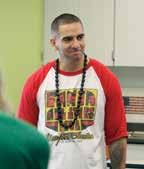
On October 27, 2023, students from St. Edmund’s Academy’s Upper School took part in the 10.27 Commemoration at Schenley Park. As part of their contribution to the event marking five years since the tragedy at the Tree of Life synagogue, the students installed the SEA Remembrance Tree, an art piece recognizing and celebrating the lives of those lost that day, as well as names and memories of loved ones lost by members of the SEA community. Following an installation in Schenley Park, this collaborative art piece is now on display in the school’s Forbes Avenue Lobby.

STAR STUDENTS AT PITTSBURGH MINADEO
Pittsburgh Minadeo students have been busy working hard academically and exploring their creative and athletic interests. They had a wonderful Christmas show that involved singing and instruments from each grade level for a packed auditorium. The Minadeo students again showed off their stage skills in February at a talent show. Students highlighted their skills in dancing, singing, comedy, and poetry for staff and families.
Two students must be recognized for their wonderful accomplishments. First, Torran Weston (fourth grade) traveled to Plant City, Florida for his 8U WPYAA All-Star Team football tournament. Torran plays multiple positions for his team, and they were able to bring home a third-place trophy. Torran not only shows his passion and excitement for football, but he is also an excellent student who follows all classrooms directions, works hard, and sets a good example for his fellow students. Torran brings pride to the Minadeo community.


The Carson Scholar for Minadeo 2024 is Lucy Dammerman (fifth grade). Lucy is a great leader and mentor at Minadeo. She helps the kindergarten students with their reading program and is a gifted writer. Lucy is always looking out for the younger students and is a key role model for them to look up to as an example of a well-rounded student. Lucy shows her love of learning in the classroom, enjoys creative writing, and is always a collaborative partner with her peers. Lucy also enjoys hobbies outside of school such as fencing.
36 | shuc.org
CDS NAMES NEW HEAD OF SCHOOL

Community Day School is thrilled to announce that Dr. Casey Weiss will be the next Head of School. Dr. Weiss brings passion to this position, both in her demonstrated commitment to education and her palpable enthusiasm for our school community. The genuine privilege of having a Community Day School alum return as Head of School strengthens our firmly held belief that CDS’ mission is vital to the future of the Pittsburgh Jewish community. Community Day School thanks and congratulates Avi Munro on her 20 years of leadership as Head of School. Her wisdom, creativity, and love of Jewish education impacted thousands of students profoundly.


“ I know I want to avoid a nursing home. What other choices do I have?”
An Envisage membership makes it possible to age independently and successfully in the place you call home—today and tomorrow.
Learn more about the smart way to age at home.
www.Envisage.org 412.605.4197 ➤ SCAN WITH YOUR PHONE SquirrelHillMag_Envisage_Feb24_7.5x5_QR_fc.indd 1 1/25/24 4:24 PM
BASS NOTES
My Life in Music
By Nina Cranor, 12th grader at Pittsburgh Sci-Tech
WHEN I AM STANDING ON A STAGE WITH MY BAND, MY MIND IS FULLY FOCUSED ON THE MUSIC.

As we’re performing, I’m concentrating on my hands playing the right notes at the right time and my voice singing the right words at the right pitches. All of the instruments and voices join together to form the songs that make up our setlist. Nothing in the world beats the thrill of playing song after song, creating harmony and rhythm.
My journey into the world of music started in preschool, where my teacher would play her acoustic guitar every morning. Her songs covered a variety of topics, but the truly interesting part was the beautiful sound that came out of the instrument. I was fascinated by the mysterious wooden object that the notes emanated from, so I began my pestering campaign to convince my parents to get me a guitar. After a long battle, we eventually came to a compromise: they would buy me a ukulele—an instrument similar to but smaller and cheaper than a guitar—and see if I kept up my interest.
The ukulele was my gateway to the world of music. With the four nylon strings, I started playing music whenever I could. I learned all the open chords with

burning passion and played them in every combination I could think of. Then, I started to layer words on top. I sang about anything and everything, from painting to Doctor Who characters to leaving friends behind to go to college, despite not even being in elementary school yet. If something came to mind, I would just sit in front of a microphone, press record, and start playing. Once I’d begun, I would go on for several minutes, not stopping until I was finished saying what I wanted to say or I dropped my pick, which happened more often than I would like to admit due to my still developing fine motor skills.
Some time later my parents acknowledged my determination and got me a short-scale Squier Stratocaster, and I started taking lessons at Sunburst School of Music. There, I met Mikey, a guitar teacher and my first music instructor. His skill with the guitar far surpassed my preschool teacher and anything I had ever seen before, leaving me amazed. With him I learned the basics like scales, chords, and rhythm. We drilled those skills constantly to give me a strong foundation and to support the newer skills I was learning.
38 | shuc.org YOUTH VOICES
Photo courtesy of Lorrie Cranor

The other thing I learned from Mikey was the idea of performing in a band. Mikey was part of a band called My Cardboard Spaceship Adventure. They were my first live band experience when my family and I ventured into Mr. Smalls Theater to attend their album release show. The feeling was electric, with happiness and
excitement permeating the crowd. The band, placed upon a stage smothered in spotlights, looked like they were having the time of their life playing song after song. This experience gave me a new goal to achieve in music: performing on stage with a band of my own.

YOUTH VOICES
A Preschool through 8th Grade Coed Independent School Proudly in the of Squirrel Hill stedmunds.net
Photo courtesy of Lorrie Cranor
YOUTH VOICES

Fortunately, Sunburst had a band program where students could be grouped together with people of similar skill levels to form bands. I joined a group of three other young musicians to form the band AndMore. We were an odd combination, with two drummers and two guitarists who both sang, but we started learning songs right away. The drummers would trade off between piano and drums, and the other guitarist and I would trade off on guitar and bass guitar. I spent over six years learning, playing, and performing together with these musicians and a few others who joined later.
Every song was a new experience, and every performance was a new challenge. Each song had different components and difficult passages that needed to be polished before everything could come together. The speed of “Moving to New York” by The Wombats and the complexity of “Hey Ya” by Outkast left me, a guitarist trying to learn the bass as I go, practicing for hours to get the lines right. Each performance was another mountain conquered, with a host of lessons learned along the way. From facing stage fright before our first performance to learning how to deal with outdoor performances in cold temperatures, there was always something new to challenge us. I was filled with excitement and anticipation every time I came to practice and every time I learned about a new performance. After each
performance I was left waiting for the next one to come around so I could do it all again.
Playing in a band taught me so many things. Without it, I would have never branched out into playing bass, which has now become my main instrument. I used the basics I learned on guitar as a starting point, but the bass led me into new parts of the music world. I’ve explored new techniques and styles, like the walking bass lines that are typically seen in jazz and blues, and pop slap, which is prevalent in funk and disco. I also got to play a new role in the band, since the bass is a driving force behind most songs and fills out the low end, roles that aren’t typically done by the guitar. I also got the opportunity to experiment with writing vocal harmonies and truly grow into my vocal style. Being in a group full of supportive and talented people allowed all of us to explore genres, styles, and techniques.
Without music and my band, I would have never become the person I am today. It has filled my days with happiness and has given me more confidence to do the things I want to do. It has been a constant companion no matter what has happened, and I know that it will continue to be there supporting me along the way. The skills and lessons that I learned as I explored the grand frontier of music are some that I will never forget, no matter where I end up.
40 | shuc.org
Photo courtesy of Lorrie Cranor

Creativity In The Veterinary Office
By Lawrence Gerson, VMD
ONE OF THE BEST ASPECTS OF BEING A VETERINARIAN IS THAT EVERY DAY IS DIFFERENT. The worst part of being a veterinarian is also that every day is different, and never routine. Veterinarians go to work never knowing what they might face during the day, so finding the right response to the day’s work often requires a bit of creative thinking.
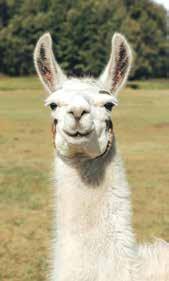
One case I will never forget came on the day after New Year’s when a newborn llama presented to my office. The baby was weak, cold, and dehydrated. The owner was surprised with the birth as he was not yet experienced in breeding these magnificent creatures. After warming the gentle creature, we tried starting intravenous fluids as it seemed like a reasonable therapy. The youngster with a huge jugular vein was not having anything to do with being treated. I was perplexed with what to try next and phoned a veterinary friend who treats farm animals. He explained to me about milk replacer and where to get it. With extrapolation from other species and some creativity, this case did just fine. I still remember the shock of our mailman who started the new year seeing
an infant llama tall enough to look him in the eyes. He left shaking his head and not saying a word.
As general practice veterinarians, we often need to use creativity to help our patients survive. Years ago, we had a dog owned by a family friend arrive in acute respiratory distress. A quick radiograph showed a diaphragmatic hernia where the smooth muscle that separates the lungs and heart in the chest from the abdominal organs is not intact. This rupture often results from a severe trauma like a car accident, but no trauma was known in this case. For the purposes of this story, we can call this dog Lucky.
Actually, he should be called Very Lucky. Medical emergencies as complex as this case are often referred to the emergency/specialty hospitals, but this dog was never going to live long enough to even get there. Within minutes, we had the dog in our surgery for repair. As bad luck would have it, the tear in the diaphragm was in the worst spot possible. It took two sets of surgical hands to save Very Lucky. Combining years of experience with help from my daughter, who was a recent veterinary graduate at the time, we used lots of creativity to successfully repair the tear. Very Lucky survived and recovered wonderfully.
Although our patients are animals, veterinarians care for their owners as well, and this too requires original and sensitive thinking rather than rote responses. At the start of the pet-owner relationship, we advise clients on proper pet and breed selection. Later, we discuss quality of life issues and counsel clients when it is time to say farewell to their pet. Sometimes we need to understand how important each pet is to the
PET POINTS
42 | shuc.org
Photo by Raspopova Marina via Pexels.
I still remember the shock of our mailman who started the new year seeing an infant llama tall enough to look him in the eyes.
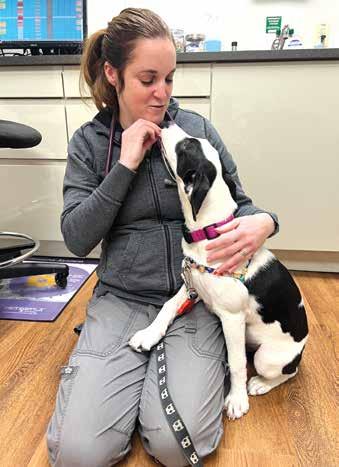
owner, knowing that some pets have extraordinary significance to the owner. We’ve had cases where the pet was formally owned by a family member who passed away or the owner was otherwise very emotionally attached. I have talked to clients who, weeks, months, or even years later, asked if they made the right decision to say goodbye. Reassuring clients about their decision-making helps them realize they acted in the pet’s best interest.
Creative financing is another way we solve problems. It’s helpful for owners who are in a difficult situation
and still want to care for a pet. We had an office policy of doing what we could for every pet regardless of the owner’s ability to pay the entire bill. Discussing options openly can benefit everyone involved in helping our pets live long and happy lives.
What clients want more than anything else is a compassionate veterinarian who they can talk to about their pet. My caring profession goes much further than just caring for animals as we always try to celebrate the wonderful bond people share with their pets.

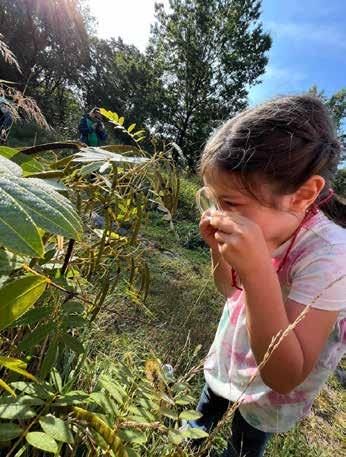
Spring 2024 | 43
inspires our students with learning that is joyful, engaging, experiential, and enduring D I S C O V E R C D S Visit comday org or call 412-521-1100 to schedule your tour of Pittsburgh's independent Jewish day school PET POINTS
CDS
By Helen Wilson, Vice-President, Squirrel Hill Historical Society
Creativity Made Visible in Squirrel Hill’s Buildings

AFTER A SQUIRREL HILL HISTORICAL SOCIETY PROGRAM A FEW YEARS AGO, I ASKED THE SPEAKER IF HE NEEDED A RIDE HOME. He said, “Drop me off at the Jefferson.” I hadn’t heard of it, so I looked it up.
It turned out that the Jefferson Apartments building is located on
Forward Avenue near the city side of the Squirrel Hill Tunnel entrance. Most people don’t notice it when they drive past because it is on the nondescript part of Forward that mostly serves as an entrance ramp to the Parkway East. Almost all of the buildings along that stretch are plain and don’t attract much attention. The Jefferson should. It’s a stately variegated brown brick 1930s-era building with a crenelated
roofline, gables, and towers, giving it a somewhat medieval appearance.
Perhaps the Jefferson is unnoticed because the Morrowfield apartment building on Murray Avenue towers above it, commanding the view. Opened in 1924 as the Morrowfield Apartment Hotel, it was the product of a deliberate effort by visionary developer Thomas A. Watkins (1861–1925) to make
44 | shuc.org SQUIRREL HILL HISTORY
The façade of the Jefferson Apartments building features a crenelated roofline, gables, and towers.
Photo by Helen Wilson

apartment living fashionable. Before then, apartments were considered suitable only for those who couldn’t afford houses. With that goal in mind, Watkins built an imposing Italianate hotel with light-brown bricks and decorative, creamcolored glazed terracotta accents. He installed the latest innovations in central heating and refrigeration. The concrete results of his creative vision were so successful that visiting stars of stage and screen and sports teams stayed there. Watkins made transportation to and from downtown easy by building one of the city’s first indoor parking garages in the city for the guests’ use. To set it apart visually from the hotel, he designed it in a completely different architectural style, using red bricks and white accents that disguised its utilitarian purpose.
Speaking of parking garages, the one that opened nearby in 2020
at the corner of Forward and Murray contains some of the most stunning artwork in Squirrel Hill. Who thinks a parking garage can’t be designed creatively? The garage was built for the Jewish Residential Services’ Seymoure and Corinne Krause Commons building across Murray Avenue. The large window openings in the garage are graced by cut-out panels of Corten Steel featuring quotations from noted poets and authors and decorated with geometric patterns and animals. The panels were created through a collaboration between artists Paul Schifino and David Lewis and the Monmade program, which promotes the incorporation of regional, sustainable design in building projects in and around Pittsburgh. One of the quotations cut into the panels reads, “Never believe that a few caring people can’t change the world, for, indeed, that’s all who ever have,” by the anthropologist Margaret Meade.
In a literal sense, caring, creative people shaped Squirrel Hill’s appearance. The neighborhood’s buildings are the result of the developers, architects, interior designers, artists, landscapers, and others whose inspired ideas took concrete form in the community. And then creative people inhabited the spaces and kept the process going.
Consider the Marlborough Building on Forbes Avenue. When a friend mentioned it to me, I didn’t know which one it was, so I researched it and found it is the building housing Bodiography Center for Movement, much more than a dance studio. In a remarkable link between then and now, its address, 5826 Forbes, was where Gene Kelly opened his first dance studio in Squirrel Hill. He later moved the studio to the building with the decorative white ceramic façade where Amazing Books, Ramen Bar, and other
SQUIRREL HILL HISTORY Spring 2024 | 45
Photo by Helen Wilson
Behind the decorative panels of the Forward and Murray parking garage one catches a glimpse of the Morrowfield building.
SQUIRREL HILL HISTORY


opened in 1926. By 1933, it had been renamed the Beacon Apartment Hotel. The building was replaced by the towering nine-story Imperial House in 1975.
When walking down Munhall Road to the Imperial House, it is interesting to look at the smaller
shops are located. Nowadays this building doesn’t have a name and is identified only by the addresses of the businesses in it, but it appears on a 1939 map showing lots and structures as the “Kamin Building,” owned by Herman Kamin (1879–1965), who, like Watkins, was a major developer of properties throughout Squirrel Hill. Unlike Watkins, when Kamin first tried to buy a property in Squirrel Hill, he was turned down because he was Jewish. He bought the property under a false name and continued to buy more properties all around the neighborhood. His building projects had a major effect on Squirrel Hill’s development, contributing to it becoming the center of Jewish life in Pittsburgh.
Meanwhile, Gene Kelly moved his studio to El Tower on Munhall Road, an apartment building that

46 | shuc.org
This building on Forbes, originally called the Kamin building, was one of multiple Squirrel Hill locations where Gene Kelly operated his dance studio.
Squirrel Hill News, Sept. 8, 1938.
Photo by Helen Wilson
Triangle Hall, with its Art Deco entrance, is an architecturally distinct apartment house on Munhall Road.
Photo by Helen Wilson
UPCOMING EVENTS
SQUIRREL HILL HISTORICAL SOCIETY
Anyone interested in learning more about Squirrel Hill history is invited to attend the programs of the Squirrel Hill Historical Society, held on the second Tuesday of each month at 7:30 p.m. at the Church of the Redeemer, 5700 Forbes Ave. The programs are also on Zoom. Go to www.squirrelhillhistory.org to request a link to the Zoom program and for updates and announcements of upcoming lectures and events. Please consider joining the SHHS. Membership is only $15 per year ($25 for families). There is no charge for attending the meetings.
Tuesday, April 9
Ann Belser, Founder & Publisher, Print Newspaper
apartment houses on that street. The first thing you notice is that each has a different architectural style. The 1939 map shows these buildings were given names— “Grandview,” “Ruth,” “Strafford Arms,” “Frederick,” “Armada,” “Windsor,” and the aptly named “Triangle Hall”—when they were erected, as were several apartment buildings on Hobart and Wightman Streets.
The practice of naming properties was not new. The Warrantee Atlas of Allegheny County, Pennsylvania, published in 1914, is a compilation of the deeds of the earliest landowners in the county. Those first landowners gave names to
Tuesday, May 14
Dr. Matthew Johnson-Roberson, Director of the Robotics Institute at Carnegie Mellon University
their tracts of land. John Turner’s was “Federal Hill,” now the name of the small street beside Turner Cemetery. His friend Jake Castleman called his property “Castlemania.” John Woods, who laid out downtown Pittsburgh, named his property “Green Woods.” (The Warrantee Map can be found on the Historic Pittsburgh website, historicpittsburgh.org.)
These early settlers can be seen in the New Deal mural in the Squirrel Hill Post Office, a building with an Italianate style of architecture— notice the columns at the door. The mural was painted in 1942 by Alan Thompson after a committee settled on “The History of Squirrel
Tuesday, June 11
Lynn McMahon, author of The Story Behind the Smile: Eat’n Park
Hill” as its theme. The mural echoes the old days of Squirrel Hill but also shows a scene from Thompson’s time—Forbes and Murray Avenues with their bustling businesses during World War II—tying past and present together.
The history of Squirrel Hill is made visible in its buildings; their architecture, their design, and even their names preserve pieces of the past. Researching that history brings to light the creativity of the people who made those buildings a reality. I’ve barely scratched the surface of that fascinating history, and I’ll continue to research and report on it.
Spring 2024 | 47 SQUIRREL HILL HISTORY
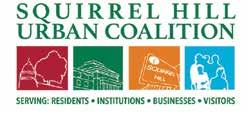
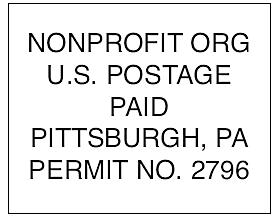













































































 By Melissa Eppihimer
By Melissa Eppihimer







 NOTES FROM YOUR SQUIRREL HILL URBAN COALITION STAFF
NOTES FROM YOUR SQUIRREL HILL URBAN COALITION STAFF


































